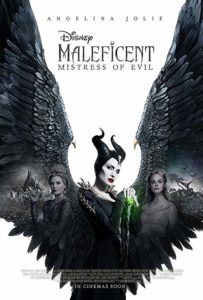Maleficent: Mistress of Evil
Posted on October 17, 2019 at 5:30 pm
B-| Lowest Recommended Age: | Middle School |
| MPAA Rating: | Rated PG for intense sequences of fantasy action/violence and brief scary images |
| Profanity: | None |
| Alcohol/ Drugs: | None |
| Violence/ Scariness: | Extended fantasy peril and violence, characters injured, cursed, and killed, disturbing images |
| Diversity Issues: | A metaphorical theme of the movie |
| Date Released to Theaters: | October 18, 2019 |
| Date Released to DVD: | January 13, 2020 |

On the 60th anniversary of that film’s release, we get this sequel to the 2014 “Maleficent,” with Angelina Jolie as a villain more sinned against than sinning. It turns out it was more than a social oversight that made her angry. She was a fairy cruelly betrayed by the human man she loved, who ruined her so he could become king (the severing of her wings was a deeply disturbing scene). Basically, she was Glenn Close from “Fatal Attraction” with horns and magical powers. Who needs to boil a bunny when you can just zap people?
But then she could not help loving the darling little Princess Aurora. The famously maternal Angelina Jolie — formerly the famously wild child Angelina Jolie — was well cast as the fairy whose anger was cooled by the love of a child. Everything ended up pretty close to happily ever after, but that doesn’t help the box office so here we are again.
Princess Aurora (Elle Fanning) is now queen of the Moors, which is fairy territory, and everyone loves her, from little pixies to Groot-like tree creatures. She floats around in hippie chick finery, and everything is blossoms and butterflies, kind, and peaceful. She accepts a proposal from Prince Philip (now played by Harris Dickinson), son of the king and queen who rule over the neighboring human country. Like so many brides before her, she implores her family, meaning Maleficent, to behave at the meet-the-prospective-in-laws dinner. And like so many meet-the-prospective-inlaw dinners, it does not go as well as the young couple hoped. Maleficent feels insulted, she lashes out, the king (Robert Lindsay) collapses, Maleficent is blamed (after all, she does know how to curse people into perpetual sleep), Aurora feels betrayed. And so, the princess stays with her new family, and Maleficent is banned again.
This time is different, though, because Maleficent finds for the first time, her own community, with horned and winged creatures like herself, though none with her magical gifts. They are outcasts, living in a secret underground community. The film’s best moments are those that make the most of the fabulously inventive visual designers and effects crew, and the “It’s a Small World”-style tour of the many variations within this group will make audiences wish for a pause button.
Unfortunately, some of the rest of the film will make them wish for a fast-forward button, including some very oddly off-key moments that give the movie a disconcertingly inconsistent tone. “I see what you did there” is not a line that belongs in what is otherwise a straightforward fantasy, not a post-modern, air-quotes, meta-take. The title character is intended to be complex, but she is just inconsistent as well. Nearly as emaciated as Joaquin Phoenix in “Joker,” with sepulchral skin and red red lips over dainty white fangs, she has heightened cheekbones that could cut glass and make Jolie look like she ate a coat hanger.
And then there is the political overlay, with messages about welcoming immigrants. non-violence, and justice for minorities that are lovely thoughts but not conveyed with any special insight or depth. More attention is given to some nonsense about creating a powder that is instantly deadly to fae folk, which is then deployed in mass quantities, but to keep the PG rating the amount of carnage is left unclear. Michelle Pfeiffer is the most vital element of the film as Philip’s mother (and her gowns and jewels are stunning), but she is not given enough to work with in the messy script, over-plotted and under-written. That’s the real villain in this fairy tale.
Parents should know that this film includes fantasy/action peril and violence much more intense than a typical PG with some very disturbing images including dissolving magical creatures, betrayal by a parent, curses, and a very sad death.
Family discussion: Why did Boora and Conall disagree? How are the issues in the movie similar to conflicts in the news? Why did Conall say we should not use our anger? Why did Aurora ask Maleficent to cover her horns and why did she apologize?
If you like this, try: the first “Maleficent,” “Sleeping Beauty,” and “Stardust”
